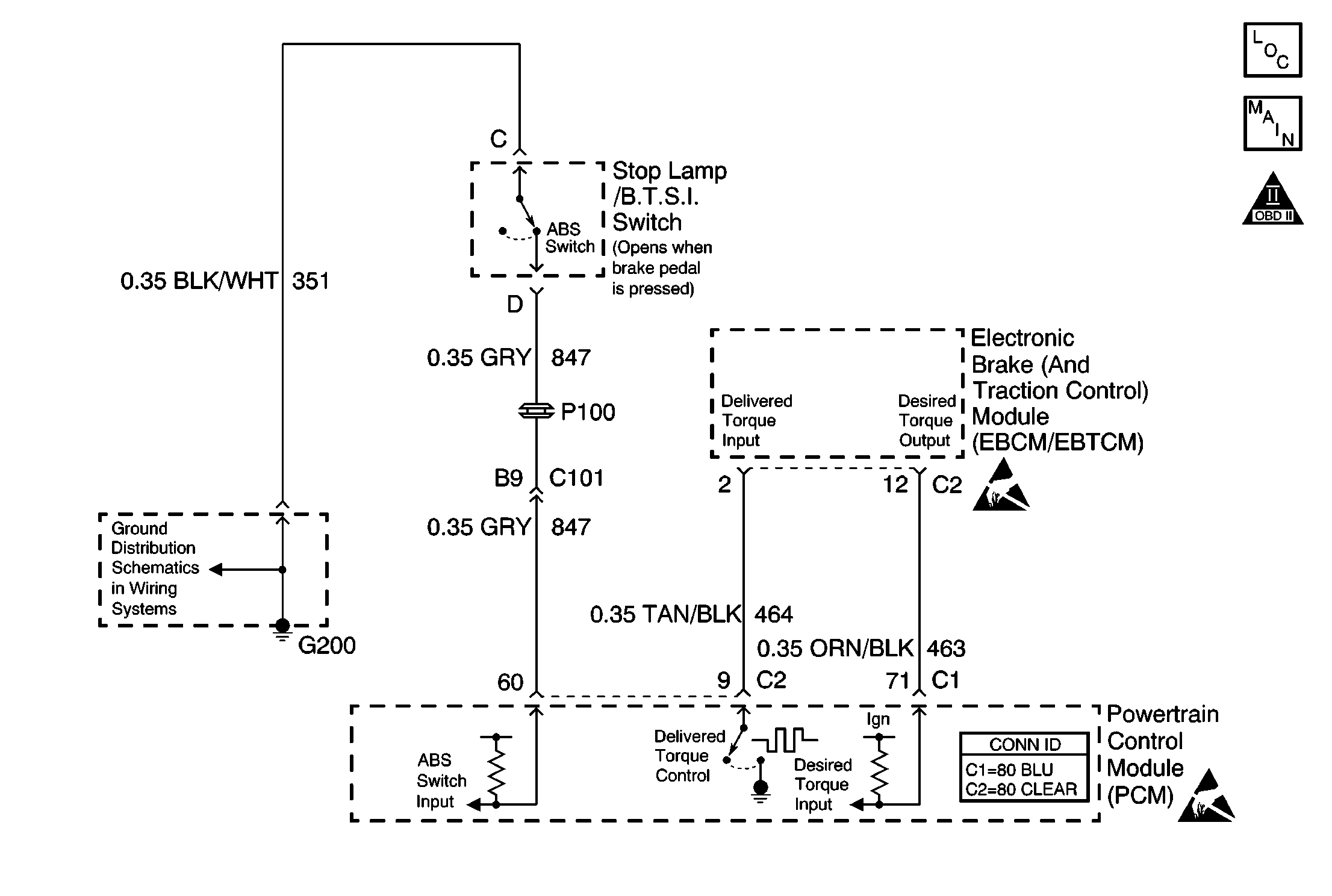
Circuit Description
This diagnostic test functions on the assumption that a brake application causes a sudden decrease in non-drive wheel speed.
The extended travel brake switch is normally closed. When the extended travel brake switch is closed, the PCM senses low voltage on the extended travel brake switch signal circuit.
If the PCM senses low voltage on the extended travel brake switch signal circuit when the switch should be open, this DTC sets.
Conditions for Running the DTC
| • | The engine speed is more than 700 RPM. |
| • | The engine has been operating longer than 2 seconds. |
| • | The wheel speed must be more than 48.28 km/h (30 mph) to enable the diagnostic. The diagnostic is disabled when the wheel speed is less than 16.09 km/h (10 mph). |
| • | The vehicle speed decreases at a rate of more than 16.74 km/h (10.4 mph) in a one second period. |
Conditions for Setting the DTC
| • | The PCM detects voltage on the extended travel brake switch circuit when the extended travel brake switch should be open. |
| • | The above conditions are present for 1.5 seconds. |
Action Taken When the DTC Sets
| • | The PCM stores the DTC information into memory when the diagnostic runs and fails. |
| • | The malfunction indicator lamp (MIL) will not illuminate. |
| • | The PCM records the operating conditions at the time the diagnostic fails. The PCM stores this information in the Failure Records. |
Conditions for Clearing the MIL/DTC
| • | A last test failed, or current DTC, clears when the diagnostic runs and passes. |
| • | A History DTC clears after forty consecutive warm-up cycles, if this or any other emission related diagnostic does not report any failures. |
| • | Use a scan tool in order to clear the MIL/DTC or disconnect the PCM battery feed. |
Diagnostic Aids
Important: Remove any debris from the PCM\TAC module connector surfaces before servicing the PCM\TAC module. Inspect the PCM\TAC module connector gaskets when diagnosing or replacing the modules. Ensure that the gaskets are installed correctly. The gaskets prevent contaminate intrusion into the PCM\TAC modules.
In order to adjust the extended travel brake switch perform the following:
- With the brake pedal depressed, insert the brake lamp switch into the retainer until the switch body seats in the retainer. You can hear clicks as you push the threaded portion of the switch through the retainer.
- Slowly pull the brake pedal fully rearward against the stop until you can no longer hear the clicks.
Test Description
The numbers below refer to the step numbers on the diagnostic table.
-
This step determines if the fault is present.
-
This step checks for a extended travel brake switch circuit for being shorted to B+.
-
This DTC will not report a pass. The scan tool status for this DTC will never report a pass. The scan tool will only display when the diagnostic fails. The repair is not complete if the scan tool indicates that the diagnostic ran and failed.
Step | Action | Value(s) | Yes | No |
|---|---|---|---|---|
1 | Did you perform the Powertrain On-Board Diagnostic (OBD) System Check? | -- | ||
Does the display indicate Applied? | -- | Go to Diagnostic Aids | ||
3 | Check the adjustment of the extended travel brake switch. Refer to Diagnostic Aids . Was an adjustment necessary? | -- | ||
Does the display indicate Applied? | -- | |||
5 |
Is the voltage greater than the specified value? | 0.5 V | ||
6 | Repair the short to voltage on the extended travel brake switch signal circuit. Refer to Wiring Repairs in Wiring Systems. Is the action complete? | -- | -- | |
7 | Replace the extended travel brake switch. Refer to Stop Lamp Switch Replacement . Is the action complete? | -- | -- | |
8 |
Important:: The replacement PCM must be programmed. Replace the PCM. Refer to Powertrain Control Module Replacement/Programming Is the action complete? | -- | -- | |
Does the scan tool indicate that this test failed? | -- | |||
10 | Select the Capture Info option and the Review Info option using the scan tool. Are any DTCs displayed that you have not diagnosed? | -- | Go to applicable DTC table | System OK |
